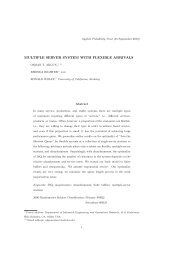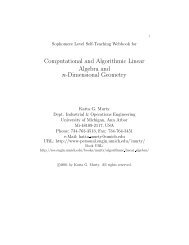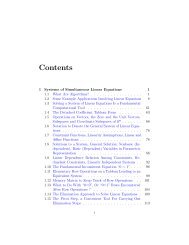Chapter 1 LINEAR COMPLEMENTARITY PROBLEM, ITS ...
Chapter 1 LINEAR COMPLEMENTARITY PROBLEM, ITS ...
Chapter 1 LINEAR COMPLEMENTARITY PROBLEM, ITS ...
You also want an ePaper? Increase the reach of your titles
YUMPU automatically turns print PDFs into web optimized ePapers that Google loves.
20 <strong>Chapter</strong> 1. Linear Complementarity Problem, Its Geometry, and Applications<br />
Proof. Let D = F +F T . D is symmetric and by Result 1.9, D is PSD. For all x 2 R n ,<br />
x T Dx =2x T Fx. So x T Dx =0too. We wish to prove that Dx =0. Let x 2 R n . For<br />
all real numbers (x + x) T D(x + x) > = 0, that is<br />
2 x T Dx +2 x T Dx > = 0 (1:16)<br />
since x T Dx = 0. If x T Dx = 0, by taking = 1 and then ;1 in (1.16), we conclude<br />
that x T Dx = 0. If x T Dx 6= 0, since D is PSD, x T Dx > 0. In this case, from (1.16)<br />
we conclude that 2x T Dx > = ; x T Dx for > 0, and 2x T Dx < = ; x T Dx for < 0.<br />
Taking to be a real number of very small absolute value, from these we conclude<br />
that x T Dx must be equal to zero in this case. Thus whether x T Dx =0,orx T Dx > 0,<br />
we have x T Dx = 0. Since this holds for all x 2 R n , we must have x T D = 0, that is<br />
Dx =0.<br />
Algorithm for Testing Positive De niteness<br />
Let F = (fij) be a given square matrix of order n. Find D = F + F T . F is PD i<br />
D is. To test whether F is PD, we can compute the n principal subdeterminants of<br />
D determined by the subsets f1g f1 2g:::f1 2:::ng. F is PD i each of these n<br />
determinants are positive, by Theorem 1.8. However, this is not an e cient method<br />
unless n is very small, since the computation of these separate determinants is time<br />
consuming.<br />
We now describe a method for testing positive de niteness of F which requires at<br />
most n Gaussian pivot steps on D along its main diagonal hence the computational<br />
e ort required by this method is O(n 3 ). This method is based on Result 1.8.<br />
(i) If any of the principal diagonal elements in D are nonpositive, D is not PD.<br />
Terminate.<br />
(ii) Subtract suitable multiples of row 1 from all the other rows, so that all the entries<br />
in column 1 and rows 2 to n of D are transformed into zero. That is, transform<br />
D into D1 as in Result 1.8. If any diagonal element in the transformed matrix,<br />
D1, is nonpositive, D is not PD. Terminate.<br />
(iii) In general, after r steps we will have a matrix Dr of the form:<br />
2<br />
6<br />
4<br />
d11 d12 ::: d1n<br />
0 d22<br />
~ ::: d1n<br />
~<br />
.<br />
0 ..<br />
.<br />
drr ::: drn<br />
.<br />
.<br />
.<br />
0<br />
.<br />
.<br />
dr+1r+1<br />
^<br />
.<br />
.<br />
::: dr+1n<br />
^<br />
.<br />
.<br />
0 0 0 dnr+1<br />
^ ::: dnn<br />
^<br />
Subtract suitable multiples of row r +1in Dr from rows i for i >r+1,so that<br />
all the entries in column r +1and rows i for i > r +1 are transformed into 0.<br />
3<br />
7<br />
5<br />
:










